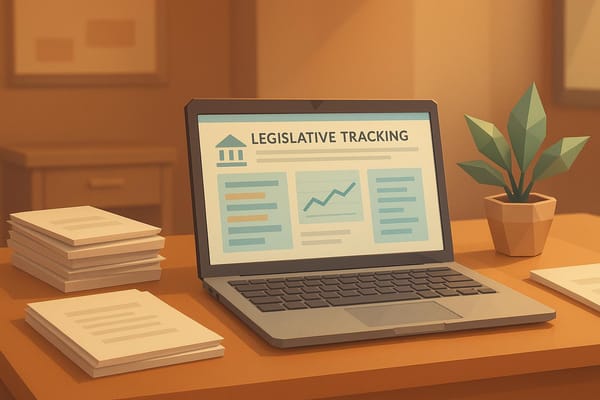How Automation Transforms Legislative Drafting
Explore how automation is revolutionizing legislative drafting by increasing speed, accuracy, and public accessibility.

Automation is changing how laws are drafted, making the process faster, more accurate, and accessible. Here are the key takeaways:
- Faster Drafting: AI tools reduce drafting time by up to 90%. Estonia’s parliament cut documentation time from hours to 20 minutes.
- Fewer Errors: AI catches inconsistencies, missing clauses, and compliance issues, cutting error rates by over 50%.
- Increased Productivity: Automation saves legal teams hundreds of hours monthly, translating to significant cost savings (e.g., $42,000 per month for some firms).
- Better Access: Tools like cicada.guide simplify legislative data for public access, while platforms like Norway’s "Digital Value Chain" modernize collaboration.
Automation not only speeds up the process but also ensures higher-quality legislation and better public engagement. Ready to dive into the details? Let’s explore how this transformation is reshaping legislative workflows.
AI for the legislative process
Current Problems in Manual Legislative Drafting
Manual legislative drafting is a time-intensive process, consuming 40–60% of lawyers' working hours. This inefficiency not only delays critical legislative tasks but also highlights the need for automation to simplify and improve drafting workflows.
Manual Processes Slow Down Work
The traditional approach to drafting legislation is riddled with inefficiencies. For example, legal professionals often spend over 15 minutes just locating the correct starting template. Drafting a single standard contract manually can take up to 4 hours. Now, imagine a team handling 100 contracts annually - this adds up to roughly 400 hours of lost productivity, or about 69.4 workdays for a team managing 100 tasks. These delays create bottlenecks that slow down the legislative process significantly.
Common Drafting Mistakes
Legislative documents demand precise language, consistent terminology, and meticulous attention to detail. Even minor errors can lead to serious consequences, such as misinterpretation or unenforceable agreements.
Here’s a breakdown of common drafting errors and their impacts:
| Error Type | Impact | Prevention |
|---|---|---|
| Terminology Inconsistencies | Can lead to legal disputes and misinterpretation | Multiple review processes |
| Incomplete Future Scenarios | Creates complications in law application | Limited scenario planning |
| Lack of Detail | Results in unenforceable agreements | Often caused by time constraints |
Interestingly, firms that have adopted smart legal forms report cutting error rates by more than 50%.
Limited Access to Legislative Information
Accessing legislative information is another pain point. Several factors contribute to this issue:
- Poorly managed record systems
- Limited resources within public bodies to share information
- Officials often unaware of their obligations to provide access
- The sheer volume of legislative history materials, which can be overwhelming
One law firm shared a compelling example: by moving away from manual processes, they saved 210 hours in a single month. At a billing rate of $200 per hour, this translated into $42,000 in recovered revenue.
These challenges emphasize the pressing need for tools and systems that can make legislative drafting more efficient and error-free.
Automation Solutions for Legislative Drafting
To tackle the inefficiencies and error-prone manual processes mentioned earlier, digital automation steps in as a game-changer. By streamlining the creation of legislative documents, automation minimizes errors and saves valuable time.
Automated Task Management
Imagine automating 100 drafting tasks a year - this could free up around 69.4 workdays! That’s time legal professionals could redirect toward more strategic work. Tools like LegisPro simplify tasks such as citation tracking, organizing metadata, managing version control, and cross-referencing. For example, what used to take 4 hours for standard contract drafting can now be done in just 1 hour.
And it doesn’t stop there. With AI tools in the mix, drafting becomes even more precise by catching potential errors before they escalate.
AI-Powered Error Prevention
AI is a powerful ally in maintaining accuracy and consistency. It automates tasks like consistency checks, compliance scanning, detecting missing clauses, and managing versions. A case study by Thomson Reuters revealed that an in-house legal team cut 75% of its NDA outsourcing costs by leveraging AI tools.
| Error Prevention Feature | Impact |
|---|---|
| Automated Consistency Checks | Keeps terminology uniform across documents |
| Regulatory Compliance Scanning | Flags compliance issues in real time |
| Missing Clause Detection | Automatically identifies incomplete sections |
| Version Control | Ensures document integrity during revisions |
These AI-driven safeguards now integrate seamlessly with collaboration tools, making teamwork faster and more accurate.
Digital Collaboration Tools
Although only 10% of parliaments currently use AI-based applications, the ones that do report noticeable improvements in team coordination and document handling. For instance, the U.S. Senate employs multi-platform access, while the House opts for a single-tool approach. Meanwhile, Norway’s "Digital Value Chain" project exemplifies a coordinated effort to modernize collaboration.
J.J. Ball, legal counsel at Systemiq, highlighted the impact of such tools:
"There is substantial time savings when using CoCounsel Drafting. When we are operating on an average turnaround time of three to four business days for a response, we can cut that down to one to two business days by utilizing the tool to get drafting work done."
Digital collaboration tools enable real-time document sharing, simultaneous editing, and automated version control. These features ensure that all stakeholders can contribute efficiently while keeping documents secure and consistent.
Current Legislative Drafting Software
Today's drafting software is packed with AI capabilities and collaboration tools, making the drafting process faster and more efficient.
AI Draft Generation Tools
AI-driven tools are transforming the drafting process by significantly cutting down time and costs. These tools can generate initial drafts, suggest clauses, and ensure documents remain consistent throughout the process. For example, they’ve been shown to reduce document review time by up to 70%.
| Feature | Impact |
|---|---|
| Initial Draft Generation | Cuts drafting time by up to 90% |
| Clause Suggestions | Ensures thorough and detailed drafts |
| Compliance Checking | Speeds up reviews by 70% |
| Error Detection | Keeps documents consistent |
"Although legal AI tools can be especially useful during the initial drafting stages by expediting the research and drafting process, it's still a lawyer's obligation to validate the AI tool's research and check the entire document for accuracy".
Team Collaboration Platforms
For legislative teams, effective collaboration tools are essential. These platforms enable seamless sharing, real-time editing, and team coordination. According to Thomson Reuters, legal professionals spend 40–60% of their time drafting documents.
"Love the simplicity of setup and the complexity of opportunities".
Here are some popular platforms tailored to different needs:
| Platform | Best For | Key Features |
|---|---|---|
| Microsoft 365 Teams | Large law firms | Document sharing, video calls, Office Suite integration |
| PagelightPrime | Mid-sized firms | Document automation, case tracking |
| LEAP | Solo practitioners | Practice management, billing integration |
In addition to internal collaboration tools, public access platforms are playing a growing role in enhancing transparency and citizen engagement in legislative processes.
Public Access Tools
Platforms like cicada.guide are leading the way in making legislative information more accessible. With AI-powered bill summaries, personalized feeds, and tools to track representatives' voting records, these tools simplify complex legislative data for the public.
Recent examples highlight the impact of such tools. Gavel client Litson PLLC reported a 90% reduction in lead conversion time thanks to automation, while Streeter Law Firm now develops comprehensive plans in just 30 minutes using similar platforms.
"We're a long way away from these tools replacing associates. And because these tools are best used as a supplement for the human actually doing the work, I think that will tend to hold true for quite a long time".
Main Advantages of Automated Drafting
Automation is reshaping the way legislative drafting is done, making it faster, more accurate, and more accessible to both professionals and the public.
Increased Staff Productivity
By automating repetitive tasks, organizations can reclaim significant time and resources. For example, law firms report saving 210 hours per month through automation, which translates to approximately $42,000 in billable hours.
| Task Type | Time Savings | Annual Impact |
|---|---|---|
| Standard Contracts | 75% reduction | 300 hours saved per 100 contracts |
| Document Review | 70% faster | 69.4 workdays saved annually |
| Initial Drafting | Up to 90% faster | Varies depending on complexity |
These time savings not only improve productivity but also free up resources to focus on improving public access to legislative information.
Better Citizen Access
Automation doesn't just benefit internal processes - it also empowers citizens by making legislative information more transparent and accessible. Digital platforms are transforming how people interact with legislation. For instance, the European Parliament's "Ask the EP Archives" project has made over 2.1 million official documents available online, cutting search and analysis time by 80%. Similarly, Estonia's HANS system transcribes parliamentary debates with 95% accuracy, reducing documentation time from hours to just 20 minutes.
Platforms like cicada.guide take this a step further by offering AI-driven tools that summarize bills, track voting records, and simplify legislative engagement. This technology helps bridge the gap between lawmakers and the public, enabling more effective communication and participation.
More Effective Laws
Automation also plays a critical role in ensuring that legislation is accurate and consistent. Projects like Estonia's transcription system and Norway's Digital Value Chain demonstrate how technology can streamline the drafting process. Norway's initiative uses machine learning to improve every stage of the legislative process, from drafting to debate. Key benefits include:
- Automatic detection of inconsistencies and redundancies in drafts
- Real-time updates to reflect current laws and regulations
- Lower error rates through AI-powered reviews
These tools are especially valuable in specialized fields like criminal and cyber law, where precision is crucial. By identifying errors and improving clarity, automation helps create legislation that is both effective and easier to enforce.
Conclusion: Next Steps in Legislative Drafting
The future of legislative drafting hinges on embracing automation and fine-tuning existing systems. The global legal AI market, projected to hit $1.45 billion in 2024, is expected to grow at an annual rate of 17.3% through 2030.
To successfully integrate these advancements, organizations and governments should focus on three key areas:
1. System Optimization
Instead of overhauling entire systems, organizations should concentrate on improving what’s already in place. Experts highlight that legal drafting automation doesn’t always require replacing software; refining current workflows can deliver meaningful results.
2. AI Strategy Development
Governments need to establish strategies that blend technological advancements with human oversight. For example, countries like Estonia and Norway have demonstrated how automation can simplify legislative processes while maintaining accountability.
3. Data Security and Ethics
Prioritizing the protection of sensitive information is critical. According to McKinsey, automation could cut processing costs by around 30% in government operations. However, this efficiency must be paired with robust security measures to safeguard data.
| Implementation Priority | Key Action | Expected Impact |
|---|---|---|
| System Optimization | Refine existing workflows | Immediate efficiency gains |
| AI Strategy Development | Develop training programs for staff | Improved capabilities |
| Security & Ethics | Use ISO and SOC 2 certified platforms | Enhanced data protection |
These steps provide a strong foundation for future advancements. By focusing on these priorities, legislative bodies can harness emerging technologies like blockchain and AI-driven compliance tools. These innovations promise to enhance efficiency, ensure accuracy, and improve transparency - all while keeping sensitive information secure.
FAQs
How does automation make legislative drafting more accurate and consistent?
Automation plays a key role in boosting the accuracy and consistency of legislative drafting. By minimizing human errors and maintaining standardized formatting, AI-powered tools ensure legal documents meet established guidelines. These tools can automatically identify inconsistencies in legal language, helping to create uniformity across multiple drafts.
Beyond accuracy, automation also simplifies repetitive tasks like drafting commonly used clauses and handling formatting. This frees up legislative teams to concentrate on more complex decision-making. By improving both efficiency and precision, automation enables the production of high-quality legal documents in less time.
What challenges does manual legislative drafting face, and how can automation help?
Drafting legislation manually comes with its fair share of challenges. Legal language is often intricate, requiring absolute precision, and the pressure to meet tight deadlines only adds to the complexity. On top of that, drafts must be clear enough for both legal professionals and the general public, making the task even more demanding.
This is where automation steps in to ease the burden. By streamlining workflows, it cuts down the time spent on repetitive tasks like research and drafting. AI-powered tools can summarize bills, spot inconsistencies, and ensure procedural rules are followed. With these tools improving both efficiency and accuracy, legislative teams can shift their focus to crafting meaningful policies instead of getting bogged down by administrative tasks.
How do digital tools improve legislative drafting and make laws more accessible to the public?
Digital tools are transforming how legislative drafting gets done, offering real-time collaboration and boosting efficiency. Lawmakers, legal professionals, and stakeholders can now work together simultaneously, making it easier to get quick feedback, make precise edits, and keep drafts updated. Tools like version tracking and shared document access help minimize mistakes and cut down on miscommunication, simplifying the entire drafting process.
These tools also enhance transparency and encourage public involvement by making legislative documents easier to access. People can follow the progress of bills, review relevant documents, and stay updated on any changes. This creates opportunities for citizens to stay informed, engage in meaningful discussions, and advocate for the issues they care about most.




